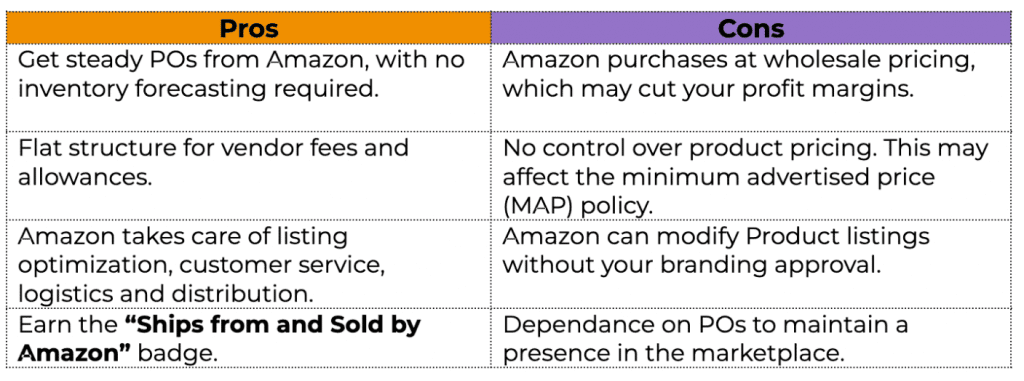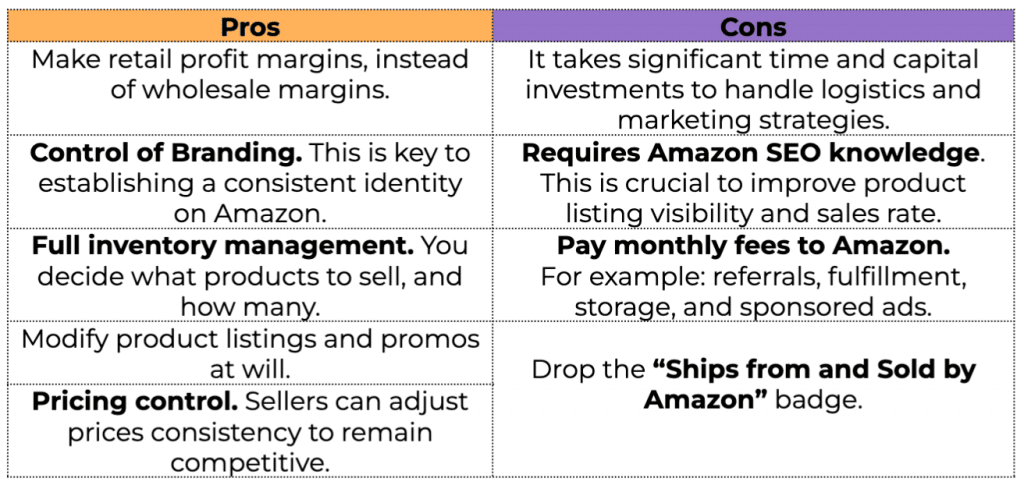In this article, we’ll go over the differences between Amazon 1P vs 3P sellers. We’ll review everything you need to know about each business model to help you choose the best options for your brand.
You may have heard the terms 1P and 3P-merchant before.
But, what do they mean on Amazon?
- 1P (First-Party) Merchants a.k.a Vendors. They use Vendor Central as their main hub in the marketplace.
- 3P (Third-Party) Merchants a.k.a Sellers. Such brands sell on Amazon as retailers. They use Seller Central to manage sales marketing, and customer experience.
Each selling model has a different relationship with Amazon.
Plus, they both must give up some control of their operations to Amazon.
So far so good – but which one is the best option for you?
Let’s find out!
Key Amazon Seller Insights
Selling on Amazon is a must for many brands. And the reason behind it, is that the marketplace has built up a massive customer base over the years.
According to our friends at Jungle Scout, as of 2022, Amazon sellers are divided as such:
- 82% are 3P sellers
- 21% are 1P sellers
- 3% sell using both models
Plus, nearly 3,700 new brands enroll in Amazon every day.
The retail giant boasts over 300 million consumers worldwide. Plus, the marketplace gets almost 2.7 billion monthly visits.
As of early 2022, 66% of users start their product search on Amazon. It’s no wonder so many merchants want in on Amazon.
Most are fortunate enough to find success in the marketplace. In fact, 76% of Amazon sellers are profitable, according to Jungle Scout.
But don’t be fooled, it takes a lot to make it on Amazon. For starters, you must choose the right business model for you.
Let’s review the Amazon 1P vs 3P models, respectively.

Infographic by AMZ Advisers
What is Amazon 1P?
First Party Sellers are better known as Amazon Vendors. This program is about selling products directly to Amazon as wholesale suppliers. Here’s how it works:
- Vendors negotiate purchase orders (POs) and send products to Amazon warehouses.
- Product ownership transitions to Amazon.
- The marketplace marks the products with the badge “Ships from and sold by Amazon.”
- From then on, Amazon sets the unit prices and sells the products to customers.
1P sellers can manage POs using Vendor Central. Here, vendors can manage POs and track shipments. In some cases, sellers can also update listings, and even run ads on Amazon.
Of course, Amazon may charge extra fees for any allowances given to vendors. For example: co-ops, merchandising, advertising, and chargebacks.
Note that Amazon Vendors is an invite-only program, which sellers can get in a few ways:
- Have a top status brand in the marketplace.
- Have high-selling FBA or FBM products.
- Request an invite to the Vendor program.
Some merchants consider 1P the easiest way to sell on Amazon. The drawback is that you give up almost all control to Amazon.
Related Content: How to Become an Amazon Vendor
Amazon 1P Seller: Pros and Cons
Let’s review the perks and setbacks associated with an Amazon 1P seller model:

What is Amazon 3P?
Third Party brands are retail merchants that sell on Amazon. Unlike 1P sellers, 3P sellers retain most control of their Amazon store.
3P sellers handle the product from start to finish of the sales funnel. That means control over fulfillment, marketing, supply logistics, and delivery.
There are two programs which 3P brands can use to sell on Amazon:
- Fulfillment by Amazon (FBA). Amazon handles order fulfillments for a fee. Sellers focus on marketing, sales and keeping a healthy stock.
- Fulfillment by Merchant (FBM). Sellers handle fulfillment through their own means, or through a logistics provider. It’s a great option to stay on top of quality control.
Seller Central is the main hub for 3P sellers. Here, brands can take control of their Amazon business. Here’s what you can do:
- Submit and update product listings
- Adjust item pricings
- Set up Amazon marketing campaigns
- Track inventory levels
- Submit keywords to boost visibility
- Review order and delivery status
Many merchants select 3P selling because it is a cost-effective way to start an Amazon business. That does not mean it’s an easy task, though.
Amazon 3P Seller: Pros and Cons
Here are the pros and cons of the Amazon 3P seller model:

It takes a lot of work to set up a third-party store on Amazon. Luckily, you don’t have to do it on your own.
JungleScout states that 16% of 3P sellers work with an Amazon Marketing Agency. These allies offer various services to help new Amazon sellers get their start. For example:
- Branding and account setup
- Product research and launches
- Marketing strategy management
- Competition analysis
There are more than 200 agencies in the US, and no one is equal to the other. It’s up to each seller to select the agency that´s best fitted to boost their Amazon sales.
Related Content: How to Find a Marketing Agency in 2022
Amazon 1P vs 3P: What’s the Difference?
Pros and cons are somewhat subjective.
One seller may benefit from leaving most of the management to Amazon. In turn, others are better off as self-governed brands.
It all depends on the nature of your store. But most of all, it’s about how involved you want to be with your ecommerce business.
So, make sure you consider the following factors when choosing your Amazon seller model:
Brand Identity
As we said, 1P sellers don’t have much say regarding product branding. You can provide descriptions, images and marketing resources up front. But in the end, Amazon has the final word. You won’t control your product listings or prices.
3P sellers have it the other way around. All product marketing falls on their hands. This means investing in branding, product research, SEO, and more. In other words, you take charge of your Amazon strategy.
Diversification
1P sellers are not forbidden to sell in other marketplaces. However, you may risk delisting if one store sells at a lower price than the other.
This means 1P sellers may be bound to sell in a single ecommerce store. Therefore, you decrease the chances to boost profits.
3P sellers control their pricing. So, they won’t risk delisting for offering cheaper offers on another website. Plus, Amazon can’t stop them if they want to enter new marketplaces.
Time and Money
3P sellers get to build an Amazon store from scratch. But it takes time, money and effort to do so.
1P sellers don’t get so many hassles. Yet, their dependence on Amazon may cut into their revenue.
Even when going with FBA, 3P sellers still need to set up and prep and pack operations. Then comes inventory management, marketing, and customer services.
It sounds like a lot – because it is. But the greater your commitment, the better profits you’ll make.
Final Thoughts
We’ve now compared Amazon 1p vs 3p selling models. Both offer great perks, but the final choice depends on your goals as an Amazon seller.
1P focuses on seamless transactions with Amazon. You won’t deal with the grittiness of retail. That said, you give up almost all control of your sales to the marketplace.
The 3P model takes more work to set up. You’ll deal with pricing, logistics, operations and customers. However, you keep control of the business, and there’s freedom for expansion.
Take the time to weigh the pros and cons of each model. Only you can say which one suits you best.
But whichever you decide on, what is important is to get started. That way, you’ll set yourself for success in the marketplace from the start.
Author

Esteban Muñoz is an SEO copywriter at AMZ Advisers, with several years’ experience in digital marketing and e-commerce. Esteban and the AMZ Advisers team have been able to achieve incredible growth on the Amazon platform for their clients by optimizing and managing their accounts and creating in-depth content marketing strategies.



